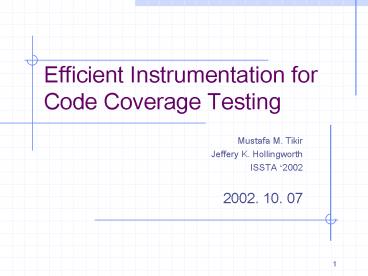Efficient Instrumentation for Code Coverage Testing PowerPoint PPT Presentation
1 / 22
Title: Efficient Instrumentation for Code Coverage Testing
1
Efficient Instrumentation for Code Coverage
Testing
- Mustafa M. Tikir
- Jeffery K. Hollingworth
- ISSTA 2002
- 2002. 10. 07
2
Contents
- Introduction
- Background
- Dominator tree
- Code coverage algorithm
- Experiments and results
- Conclusion
3
Introduction
- Evaluation of code coverage
- The problem of identifying the parts of a program
that did not execute in one or more runs of a
program - Traditional code coverage measurement tools
- Use static code instrumentation
- Have below problem
- Instrumentation all functions
- Increase instrumentation overhead
- instrumentation code remains throughout the
execution. - increase execution time
4
Our approach
- Dynamically insert code and remove
instrumentation code - Use and expand dyninst
- Reduce the number of places instrumentation code
needs to be inserted - Use dominator tree and CFG information
- Insert the necessary instrumentation code when a
function is called for the first time during the
program execution
5
Background (1/2)
- Dynunst Post-complier program
manipulation tool
Mutator
Application
doWork(int a, b) for(I0 I 1) bar(a,1)
Mutator App
Points
API
Machine Dependent Code
Snippets
Dyninst code
Ptrace/procfs
Run-time Library
6
Background(2/2)
Implementation code insertion into a program
Program
Base Tramp
Mini-Tramp
Save Registers
Pre
Set up Args
Foo()
Relocated Instruction
Snippet
Restore Registers
Post
7
Extended dyninst API
- Provide information about CFG
- Add arbitrary instrumentation points
- Originally, dyninst only supported function
level instrumentation - Involve its memory allocator
- Optimization(de-allocate and compacts) may cause
a significant overhead
8
Dominator tree (1/2)
- A node u dominates a node v.
- If every path from the entry node to v contains
u. - Denoted as u v
- Dominator tree expresses dominator relationships.
- u v iff there is a path from u to v in
the dominator tree.
9
Dominator tree(2/2)
- Covered(u,t)
- If the control reaches the corresponding basic
block at least once when the program is executed
on t - If u v and covered(v,t) then covered(v, t)
- u, v nodes in dominator tree
- t a test case
- If all leaves in the dominator tree are covered
then all other nodes in the CFG are automatically
covered
10
A CFG and its dominator tree
CFG
Dominator tree
0
0
1
1
2
3
2
3
4
4
11
Reducing instrumentation points
- Leaf node instrumentation
- Instrument all leaf node in dominator tree
- Necessary but not sufficient to produce correct
code coverage results - When there exists a cross edge originating from
internal node - Non-leaf node instrumentation
- Can capture correctly above problem
- Instrument basic block n if n has at least one
outgoing edge to a basic block m that n does not
dominate.
12
Example insufficient case
Dominator tree
CFG
0
0
1
2
1
2
3
4
3
4
Exit
13
Code coverage algorithm
- Pre-instrumentation
- Create the CFG
- Create dominator tree
- Choose basic block to be instrumented
- Attach a Boolean variable to basic block
- Insert instrumentation code
- On-demand instrumentation
- Insert breakpoints at the beginning of functions
- When a breakpoint is reached
- Generate CFG and insert instrumentation code
14
Deletion instrumentation code
- Deletion code includes
- Restoring original instructions
- De-allocating base and mini-trampoline
- Checking what is already executed
- Checking what can be deleted
- Deletion code has trade-off
- ?Delete instrumentation code at fixed time
intervals
15
Experiments
- Execute the test programs with
- Pre-instrumentation without/with dominator tree
- On-demand instrumentation without/with dominator
tree - Measure the execution time and the number of
instrumentation points varying the dynamic code
deletion interval. - Compare to purecov
- A commercial code coverage tool that uses static
code editing
16
Reduction in instrumentation points
- Pre-instrumentation
17
Reduction in instrumentation points
- On-demanding instrumentation
18
Coverage percentage curves
19
Execution time slowdown ratios
- Slowdown for SPEC/compress
20
Execution time slowdown ratios
- Slowdown for PosterSQL
21
Comparison of slowdown ratios
22
Conclusion
- Using dominator tree info.
- Reduces the number of instrumentation points
needed - Dynamic deletion of instrumentation code
- Reduces the runtime overhead
- Combining dominator tree and on-demand
instrumentation - Reduces code coverage costs
- Consider code coverage as part of production code

